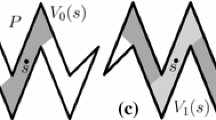Abstract
Let s be a point source of light inside a polygon P of n vertices. A polygonal path from s to some point t inside P is called a diffuse reflection path if the turning points of the path lie on polygonal edges of P. We present three different algorithms for computing diffuse reflection paths from s to t inside P. For constructing such a path, the first algorithm uses a greedy method, the second algorithm uses a transformation of a minimum link path, and the third algorithm uses the edge-edge visibility graph of P. The first two algorithms are for polygons without holes, and they run in O(n + k logn) time, where k denotes the number of reflections in the path. The third algorithm is for both polygons with or without holes, and it runs in O(n 2) time. The number of reflections in the path produced by this algorithm can be at most 3 times that of an optimal diffuse reflection path. The problem of computing a diffuse reflection path between two points inside a polygon has not been considered in the past.
Preview
Unable to display preview. Download preview PDF.
Similar content being viewed by others
References
Aronov, B., Davis, A., Dey, T., Pal, S.P., Prasad, D.: Visibility with multiple reflections. Discrete & Computational Geometry 20, 61–78 (1998)
Aronov, B., Davis, A., Dey, T., Pal, S.P., Prasad, D.: Visibility with one reflection. Discrete & Computational Geometry 19, 553–574 (1998)
Aronov, B., Davis, A.R., Iacono, J., Yu, A.S.C.: The complexity of diffuse reflections in a simple polygon. In: Correa, J.R., Hevia, A., Kiwi, M. (eds.) LATIN 2006. LNCS, vol. 3887, pp. 93–104. Springer, Heidelberg (2006)
Chazelle, B.: Triangulating a simple polygon in linear time. Discrete & Computational Geometry 6, 485–524 (1991)
Chazelle, B., Edelsbrunner, H., Grigni, M., Guibas, L.J., Hershberger, J., Sharir, M., Snoeyink, J.: Ray shooting in polygons using geodesic triangulations. Algorithmica 12, 54–68 (1994)
Foley, J., van Dam, A., Feiner, S., Hughes, J., Phillips, R.: Introduction to Computer Graphics. Addison-Wesley, Reading (1994)
Ghosh, S.K.: Computing visibility polygon from a convex set and related problems. Journal of Algorithms 12, 75–95 (1991)
Ghosh, S.K.: Visibility algorithms in the plane. Cambridge University Press, Cambridge (2007)
Ghosh, S.K., Mount, D.M.: An output-sensitive algorithm for computing visibility graphs. SIAM Journal on Computing 20, 888–910 (1991)
Guibas, L.J., Hershberger, J.: Optimal shortest path queries in a simple polygon. Journal of Computer and System Science 39, 126–152 (1989)
Hershberger, J.: Finding the visibility graph of a polygon in time proportional to its size. Algorithmica 4, 141–155 (1989)
Klee, V.: Is every polygonal region illuminable from some point? American Mathematical Monthly 76, 180 (1969)
Lee, D.T., Preparata, F.P.: Euclidean shortest paths in the presence of rectilinear barriers. Networks 14, 393–415 (1984)
Mitchell, J.S.B., Rote, G., Woeginger, G.: Minimum-link paths among obstacles in the plane. Algorithmica 8, 431–459 (1992)
O’Rourke, J., Streinu, I.: The vertex edge visibility graph of a polygon. Computational Geometry: Theory and Applications 10, 105–120 (1998)
Pal, S.P., Brahma, S., Sarkar, D.: A linear worst-case lower bound on the number of holes in regions visible due to multiple diffuse reflections. Journal of Geometry 81, 5–14 (2004)
Prasad, D., Pal, S.P., Dey, T.: Visibility with multiple diffuse reflections. Computational Geometry: Theory and Applications 10, 187–196 (1998)
Tokarsky, G.T.: Polygonal rooms not illuminable from every point. American Mathematical Monthly 102, 867–879 (1995)
Author information
Authors and Affiliations
Editor information
Editors and Affiliations
Rights and permissions
Copyright information
© 2009 Springer-Verlag Berlin Heidelberg
About this paper
Cite this paper
Ghosh, S.K., Goswami, P.P., Maheshwari, A., Nandy, S.C., Pal, S.P., Sarvattomananda, S. (2009). Algorithms for Computing Diffuse Reflection Paths in Polygons. In: Das, S., Uehara, R. (eds) WALCOM: Algorithms and Computation. WALCOM 2009. Lecture Notes in Computer Science, vol 5431. Springer, Berlin, Heidelberg. https://doi.org/10.1007/978-3-642-00202-1_5
Download citation
DOI: https://doi.org/10.1007/978-3-642-00202-1_5
Publisher Name: Springer, Berlin, Heidelberg
Print ISBN: 978-3-642-00201-4
Online ISBN: 978-3-642-00202-1
eBook Packages: Computer ScienceComputer Science (R0)




